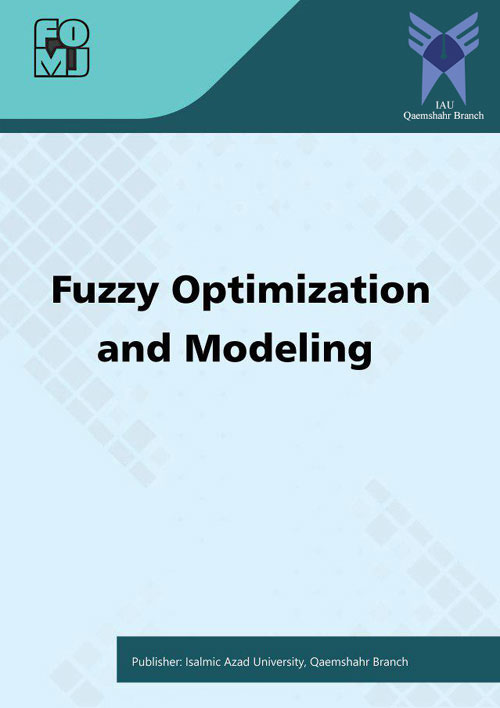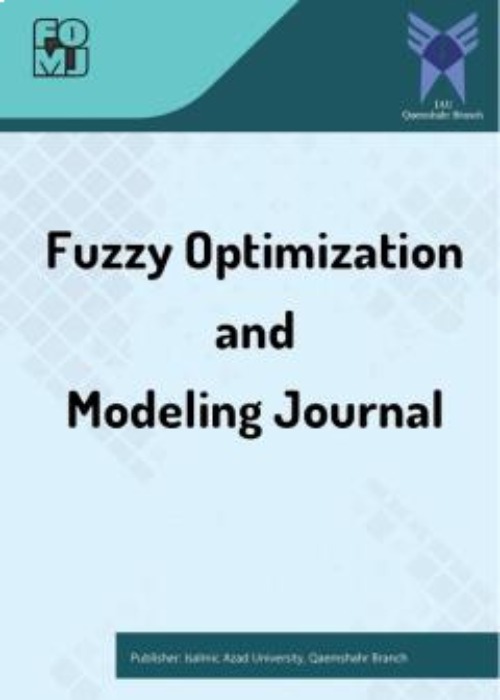فهرست مطالب

Fuzzy Optimzation and Modeling
Volume:2 Issue: 3, Summer 2021
- تاریخ انتشار: 1400/08/23
- تعداد عناوین: 6
-
Pages 1-16Conventional mathematical tools which require all inferences to be exact, are not always sufficient to handle imprecisions in a wide variety of practical fields. Thus, among various developments in fuzzy mathematics, enormous efforts have been in process to produce new fuzzy analogues of the classical fixed point results and their various applications. Following this line in this paper, a new type of set-valued mapping whose range set lies in a family of soft sets is examined. To this effect, we introduce a few fixed point theorems which are generalizations of several significant fixed point results of point-to-point and point-to-set valued mappings in the comparable literature. Some of these particular cases are noted and analyzed. Moreover, nontrivial examples are provided to support the assumptions of our main results.Keywords: Soft set, Soft set-valued map, e-soft fixed point, fuzzy set, Fuzzy mapping
-
Pages 17-23Regression models have been tremendously studying with so many applications in the presence of imprecise data. The regression coefficients are unknown i.e., they cannot be restricted. To the best of our knowledge, there is no approach except Chen and Hsueh approach (IEEE Transactions on Fuzzy Systems, vol. 17, no. 6, December 2009 pp.1259-1272) which can be used to find the regression coefficients of a fuzzy regression model without considering the non-negative restrictions on the regression coefficients. Chen and Hsueh have used some mathematical assumptions which lead to limitations in their approach. Furthermore, Chen and Hsueh approach is inefficient regarding to computational complexity. This paper proposed a simplified approach overcoming the limitations and computational complexity of Chen and Hsueh approach which can be considered by the researchers who would like to use Chen and Hsueh approach in real life applications.Keywords: distance, Fuzzy regression model, fuzzy sets, Least squares method
-
Pages 24-35The quadratic assignment problem (QAP) is one of the combinatorial optimization problems belonging to the NP-hard problems’ class and has a wide application in the placement of facilities. Thus far, many efforts have been made to solve this problem and countless algorithms have been developed to achieve optimal solutions, one of which is the Genetic Algorithm (GA). This paper aims at finding a suitable layout for the facilities of an industrial workshop by using a developed genetic algorithm and Taguchi Method (TM). The research method in the current study is mathematical modeling and data was analyzed using genetic algorithm in Minitab and MATLAB. The results show that the Developed Genetic Algorithm (DGA) is highly efficient, as it has the power to discover many optimal solutions. Therefore, according to the obtained results, it is recommended that when the genetic algorithm (GA) is used to solve problems, it is better to run this algorithm several times; because the proposed method increases the variety of answers in the genetic algorithm and power for discovering the optimal solution becomes more.Keywords: fuzzy sets, Optimization, Facility's Layout, quadratic assignment problem
-
Pages 36-46The main aim of this study is to construct a new approximation method for solving stif Itˆo stochastic ordinary diferential equations based on explicit Milstein scheme. Under the suicient conditions such as Lipschitz condition and linear growth bound, we prove that split-step (α, β)-Milstein method strongly convergence to exact solution with order one. The means-quare stability of the our method for linear stochastic diferential equation with one-dimensional Wiener process is studied. Stability analysis shows that the mean-square stability our proposed method contains the mean-square stability region of linear scalar test equation. Finally, numerical examples illustrates the efectiveness of the theoretical results.Keywords: Itˆ o stochastic ordinary diferential equations, strong convergence, Mean-square stability
-
Pages 47-55
One of the major concerns in healthcare management is the optimal allocation of staffing and resources. The global crisis created by the COVID-19 Pandemic has created extreme strains both on the staffing and the resources available to the healthcare systems. It has geometrically added to the number of patients seeking health services. In addition, the Pandemic has dramatically increased the rate of mortality in the hospitals in an unprecedented way. Therefore, in this research, in order not to sacrifice the quality of the services provided, we have used Data Envelopment Analysis (DEA) model to determine the efficiency of the emergency departments in the hospitals and the possible improvements that could be made to them. As traditional DEA models do not seek to reduce the undesirable outputs and increase the undesirable inputs, in addition to determining the efficiency of decision making units (DMU) despite some undesirable input components, the effect of these units on performance is investigated. To this end, considering the problem assumptions, first, a set of proper production possibilities is defined. Finally, a new method is introduced to determine the system’s performance in the presence of some undesirable input components. The impact of undesirable components on determining efficiency is specified, and a real example is provided consisting of emergency rooms in 30 hospitals, in which five desirable inputs and four desirable outputs along with one undesirable input are considered. The example is solved using the presented model, and the efficiency scores are determined.
Keywords: COVID-19, DEA, Efficiency of Hospitals, Efficient Frontier, Undesirable Inputs -
Pages 56-62
Forex indicators are one way of examining market data. One of the best methods is using approximations of quadratic curves. For example, the Parabolic SAR indicator is an indicator that approximates the trend by a parabola. Of course, not all indicators necessarily map the direction of the trading trend with a curve, but discovering a clear curved path for the trading trend is definitely the dream of many great analysts. The problem that we are dealing with here is actually trying to generalize the idea of approximating the direction of the trading process by using hyperbolic functions. Suppose there are two fixed points in the movement of the financial market and the path length between these two points is also a fixed number, using numerical approximation methods, we try to calculate the maximum and minimum amount of financial market movement. The main idea that is in our minds is the approximation of financial market trends by using hyperbolic functions. We approximate the path between these two points with a hyperbolic sine function. Finally, we try to find the maximum or minimum points of this hyperbolic sine function numerically.
Keywords: Optimization, Indicators, Hyperbolic Indicator, Numerical Method


